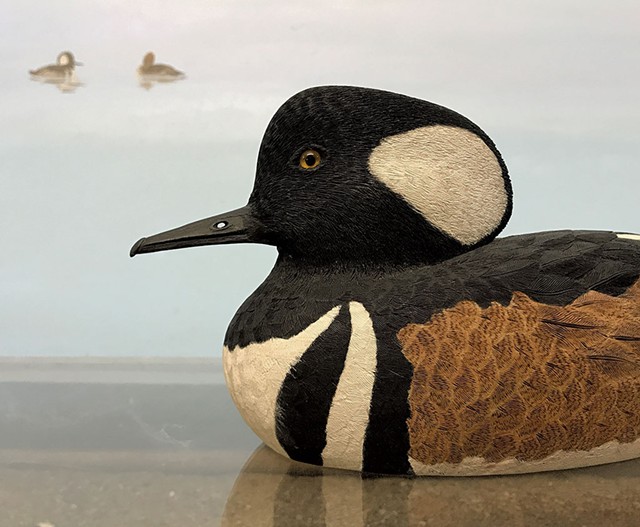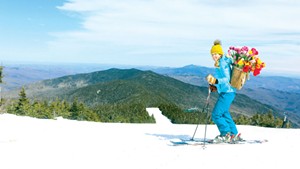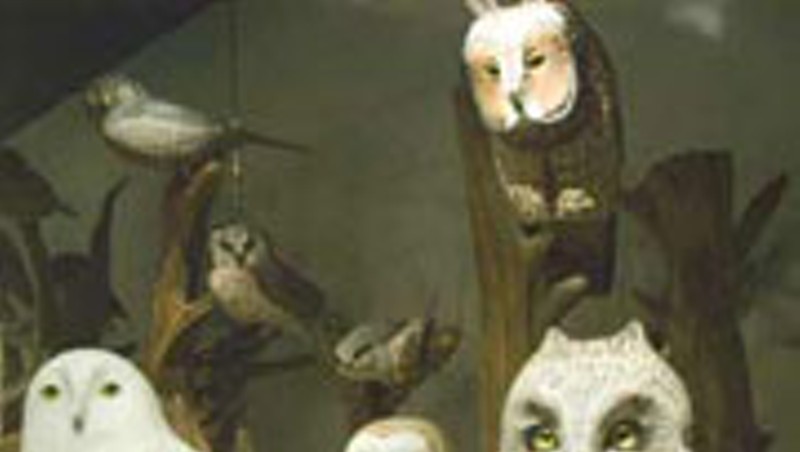
- Courtesy
- Wood carving at the Birds of Vermont Museum
The weather wasn't at all springlike as I arrived at the Birds of Vermont Museum in Huntington on an early Saturday morning in late January. With the temperature hovering at minus 2 degrees Fahrenheit and the windchill gnawing at 22 below, I felt certain that no one else would show up for the museum's monthly bird-monitoring walk, including the birds themselves.
Like many of my assumptions about birds and birding that day, I was wrong.
Among the first arrivals was a hardy couple from western New York. Ray Kasprzyk of Buffalo and his partner, Lauren Watkins, of Rochester are avid birders who were visiting Vermont for the weekend. The couple braved the arctic weather to learn which feathered fliers could be seen in the Green Mountains.
We were soon joined by Kathleen Stutzman, a conservation forester who lives in Huntington. She started attending these monthly walks last year to get more adept at identifying the species she routinely encounters in her work.
"There's so much to know, but I've definitely learned a lot in the time I've been coming here," Stutzman said.
Our guide for the morning was Erin Talmage, executive director of the Birds of Vermont Museum. The nonprofit conservation and education center hosts these monitoring walks year-round on the last Saturday of the month as part of its larger mission of teaching the public about the diversity of avian species that live in and migrate through Vermont.
Cofounded in 1987 by naturalist, author and educator Bob Spear and his life partner, Gale Lawrence, the museum houses life-size, realistic and intricately detailed wood carvings of Vermont birds — raptors, waterfowl, and endangered and extinct species — including more than 500 carved by Spear, who died in 2014 at age 94. In addition to two floors of exhibits, the museum has a one-way viewing window ideal for watching wild birds up close.
The monthly monitoring walks are more than recreational activities; they also serve a valuable function as citizen science. As Talmage explained, the collected bird sightings are entered into eBird, an online database maintained by the Cornell Lab of Ornithology in Ithaca, N.Y. That info allows researchers to see, in real time, which species are where, and to build computer models for mapping migratory patterns and changes to bird habitats. Birders with an eBird account can also use the app to look up which species they might encounter in places they travel.

- Courtesy
- Wood carving at the Birds of Vermont Museum
Watkins noted that she's seen a lot more robins in Vermont than she normally sees in Rochester this time of year. Though I had always assumed that robins were harbingers of spring, Talmage explained that many of the ones seen in Vermont this time of year are actually northern robins from Canada that winter here.
Because of the severe cold, Talmage led us on an abbreviated loop through the woods across the road from the museum. Visitors are free to explore the trails on the museum's 100-acre property, which is adjacent to Audubon Vermont's 250 acres. Together, these contiguous woods provide a rich habitat for resident and migratory species alike.
"Every bird walk is really different, depending on the season," Talmage said. "Even standing here in the parking lot, we're hearing a lot more birds than we did at the end of December."
Bird monitoring is pretty straightforward. Our group would walk a short distance, then stand quietly for a few minutes, listening and scanning the trees with binoculars. In spring and summer, Talmage explained, some birders will engage in "pishing," which involves mimicking the alarm call of a predator, such as a screech owl, in order to attract flocks of smaller birds, which will fly over to check out the threat. However, because the practice requires the birds to expend precious energy, Talmage said, it's not advised in winter.
Though I often search the trees and skies for interesting birds, especially the raptors that hunt in the fields alongside my house near Mount Philo, I was the only one in our group of five who wasn't an experienced birder. Even as I scanned the woods, trying (mostly unsuccessfully) to distinguish a bird from a clump of dried leaves or twigs, others in the group were quickly calling out different species they heard or saw.
"I'm thinking I'm hearing a titmouse, but it might be a chickadee," Watkins chimed.
Several in the group identified two woodpeckers a mere 10 yards from the road: a hairy and a downy. I couldn't tell them apart, even when I looked them up later on the internet. Both are black and white, and the males of both species have a red patch on their heads.
"That's a red-bellied woodpecker," Talmage said, adding a third to our list. She noted that the species has only been seen in this area for about a decade.
After a few minutes, we continued on toward a shallow, snow-covered pond with a bird blind beside it. Talmage noted that last year a beaver took up residence there and built a lodge, which changed the water flow and prevented the pond from drying out in the summer. Whether the increase in insects would attract more birds over time, Talmage couldn't say.

- Courtesy
- Museum and walking trails in springtime
Come spring, visitors often can see rose-breasted grosbeaks and red-winged blackbirds near here, she said, as well as great crested flycatchers, which sometimes nest nearby. By Mother's Day, Talmage said, the hummingbirds arrive. These and other species can be seen more easily through the one-way viewing window inside the museum.
After a few minutes, we continued around the pond and trudged up the hill — and suddenly there was a brief commotion in a stand of hemlocks. Talmage immediately identified it as a ruffed grouse we'd flushed from its slumber. Ruffed grouse often sleep beneath the snow, she explained, where the ground temperature can be 30 degrees warmer than the air above it.
At the conclusion of our hourlong walk, the group went inside to warm up, drink tea, and explore the dioramas, gift shop and viewing window. The Birds of Vermont Museum has fared well through the pandemic, Talmage noted, in part because many of its educational programs are held outdoors. Indoors, Spear's intricately carved creatures vastly outnumber the museumgoers, which have been limited to no more than 20 at a time during the pandemic.
For live birds, we documented 11 species, not including the rooster crowing down the road.
"That's pretty good for January and this temperature," Talmage said. But come May and June, bird monitors can see as many as 30 different species in a single walk. According to eBird, the museum has documented a total of 135 species on its property; the neighboring Audubon Society, 141.
"Not that there's any competition," Talmage said with a smile.













Comments
Comments are closed.
From 2014-2020, Seven Days allowed readers to comment on all stories posted on our website. While we've appreciated the suggestions and insights, right now Seven Days is prioritizing our core mission — producing high-quality, responsible local journalism — over moderating online debates between readers.
To criticize, correct or praise our reporting, please send us a letter to the editor or send us a tip. We’ll check it out and report the results.
Online comments may return when we have better tech tools for managing them. Thanks for reading.